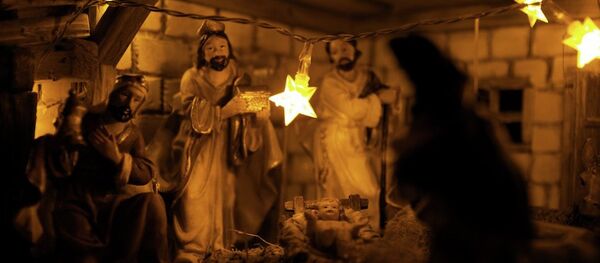MOSCOW, December 24 (Sputnik) — Christmas, celebrating the birth of Jesus Christ, is one of the main Christian holidays. The Roman Catholic Church and most Protestant churches celebrate Christmas according to the Gregorian calendar on December 25.
The decision to celebrate Christmas on December 25 was made at the third ecumenical Council of Ephesus in 431 by Roman Emperor Theodosius II.
Christmas is preceded by Advent, which starts four weeks before Christmas and is supposed to prepare the faithful for a deeper experience in celebrating the birth of Jesus.
A detailed account of his birth is provided by Luke the Evangelist: “And Joseph too went up from Galilee from the town of Nazareth to Judea, to the city of David that is called Bethlehem, because he was of the house and family of David, to be enrolled with Mary, his betrothed, who was with child. While they were there, the time came for her to have her child, and she gave birth to her firstborn son. She wrapped him in swaddling clothes and laid him in a manger, because there was no room for them in the inn.”
Since Joseph was a descendant of David, he went to Bethlehem. After the birth of Jesus, shepherds were the first people who came to worship him. They were notified of Christ’s birth by an angel, who had appeared to them. According to Saint Matthew, a miraculous star appeared in the sky and led the three magi (wise men) to the baby Jesus. They gave Christ gifts — gold, incense and myrrh. At the time, the holy family had already found shelter in an inn.
After learning of Christ’s birth, Herod, the king of Judea, ordered the death of all infants under the age of 2, but Jesus was miraculously saved. However, Joseph's family had to flee to Egypt and stayed there until the death of Herod.
According to early Roman Christian tradition, three special liturgies are served on Christmas day – a midnight Mass, a Mass at dawn, and a Mass during the day. Thus, Christmas is celebrated three times – as the eternal birth of the Word of God the Father at midnight, the Virgin Birth of the Son of God at dawn, and the birth of God in the soul in the afternoon. Christmas Eve Mass is served on the evening of December 24.
Christmas celebrations last for eight days, from December 25 to January 1, a period known as the Octave. December 26 is celebrated as St. Stephen the Martyr Day. December 27 is marked as the day of John the Apostle and the Massacre of the Innocents is commemorated on December 28.
The Sunday falling on one of the days between December 26 and 31, or on December 30, if none of these days fall on a Sunday, is celebrated as the Day of the Holy Family: the baby Jesus, Mary and Joseph. January 1 is celebrated as the Solemnity of Mary, Mother of God.
The Christmas period continues even after the Octave until Baptism, which in the Roman Catholic calendar is celebrated on the first Sunday after Epiphany (January 6). Throughout the Christmas period, the clergy wear white robes during liturgies.
On Christmas, most Italians and Vatican residents serve roast beef and sweet Christmas cakes known as panettone or pandoro. The former is similar to the Easter cake and the latter is a yeast cake originating in Verona. For Christmas, Italians usually exchange gifts called torroncino, sweets similar to nougat and roasted nuts.
In Germany, various regions have their own traditional Christmas pastries such as gingerbread in Nuremberg, shaped gingerbread in Aachen, and fruitcake and cinnamon stars in Dresden.
A yule log, a biscuit roll decorated with cream, frosting and chocolate is traditionally served at Christmas in many European countries.
Lit candles are one of the main Christmas symbols. Its flickering flame is supposed to remind the faithful of the words found in the Gospel: "The light shines in the darkness and the darkness has not overcome it."


